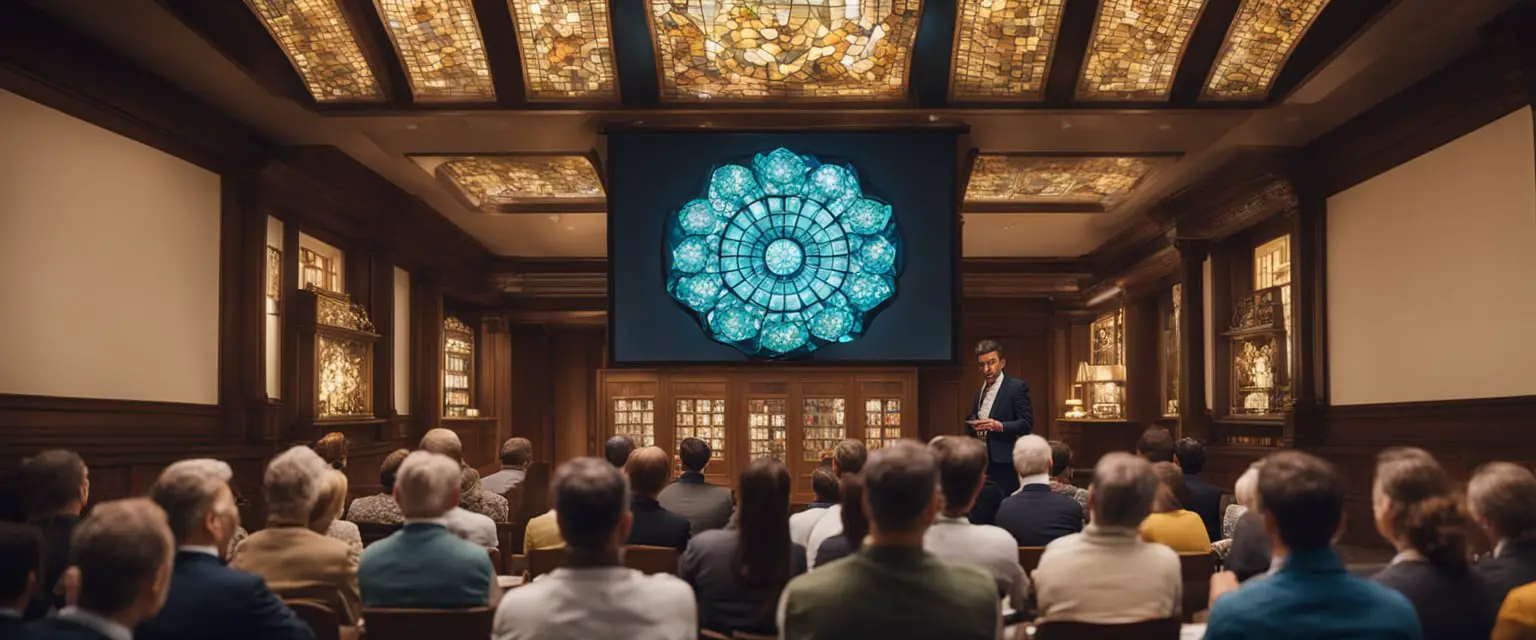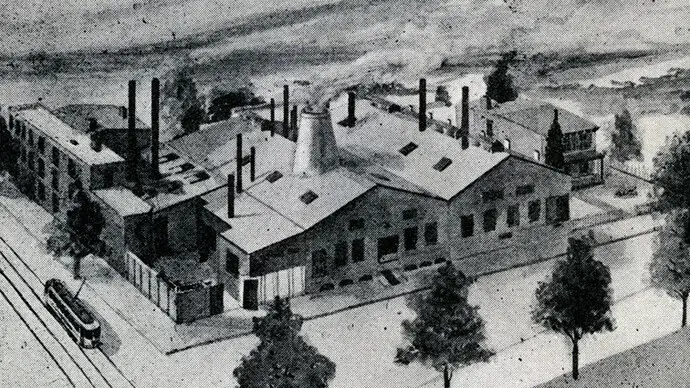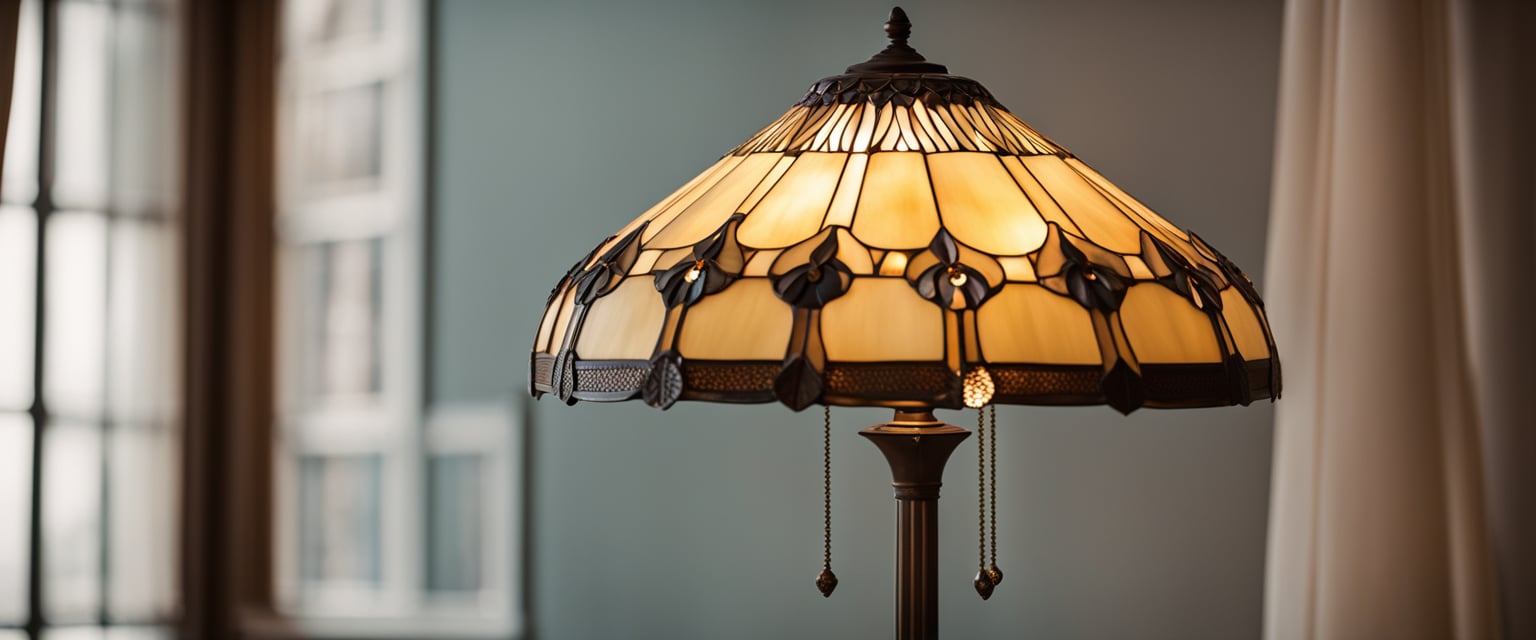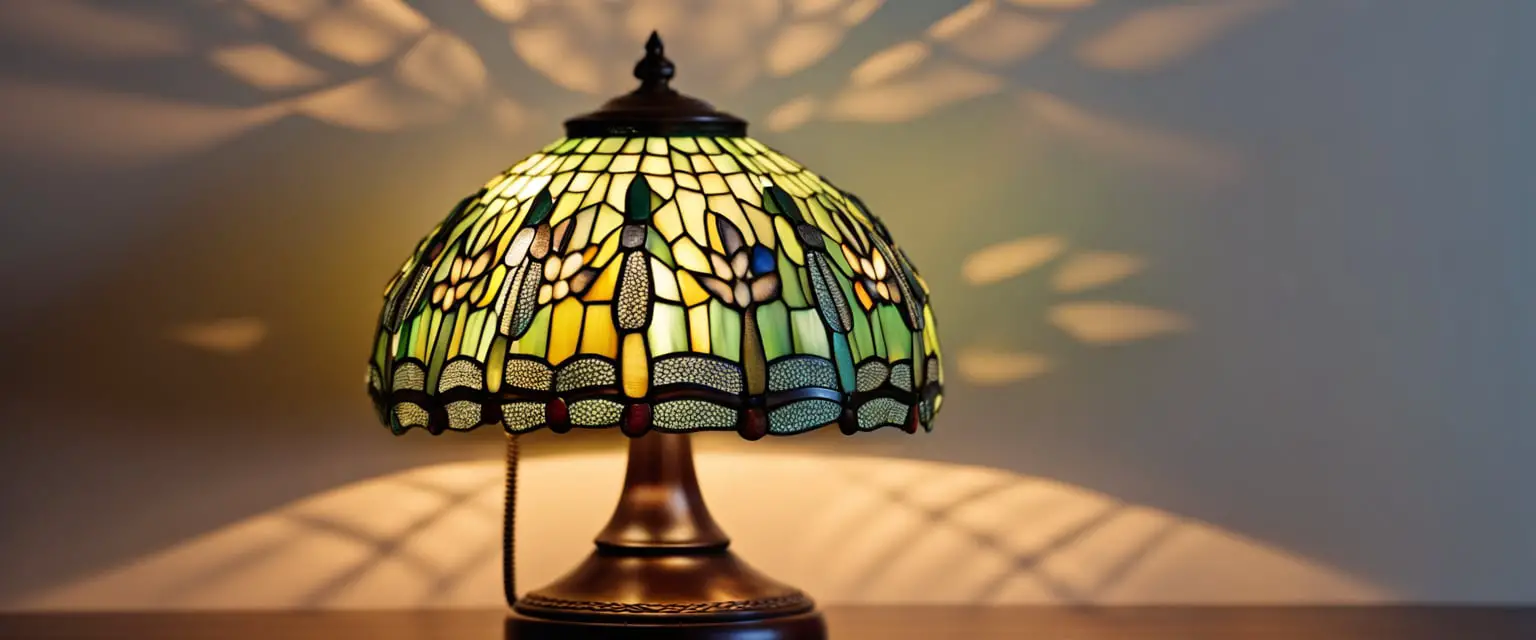A Tiffany lamp is a timeless masterpiece characterized by its exquisite stained glass shade, intricate design, and ornate metal base, embodying the visionary artistry of Louis Comfort Tiffany. A Tiffany Lamp encapsulates the epitome of craftsmanship and elegance, representing a harmonious fusion of art and functional lighting that continues to captivate enthusiasts and collectors worldwide.
This post serves as an illuminating guide, offering a comprehensive exploration of the defining characteristics and historical significance of Tiffany lamps. Whether you’re a newcomer to the world of art and design or a seasoned enthusiast, considering this post as a Tiffany Lamp wiki will enrich your understanding of these iconic pieces, celebrating their enduring allure and the legacy of the visionary artisans behind them.

Table of Contents
Introduction to Tiffany Lamps
Tiffany lamps are decorative lamps with a stained glass shade. They are named after Louis Comfort Tiffany, an American artist and designer who created them in the late 19th century. Tiffany lamps are considered part of the Art Nouveau movement, popular in Europe and the United States from the 1890s to the early 1900s.
Authentic Tiffany Lamp vs. Tiffany Style Lamp
The primary difference between a genuine, authentic Tiffany Lamp and Tiffany Style Lamps is their origins and craftsmanship.
Genuine Tiffany Lamps were crafted by Louis Comfort Tiffany and his artisans during the late 19th and early 20th centuries. They are characterized by their high-quality materials, intricate designs, and meticulous handcrafted construction.
On the other hand, Tiffany-style lamps are modern reproductions or interpretations inspired by the original Tiffany designs. They are often mass-produced using similar stained glass techniques and decorative motifs. While both types may exude beauty and elegance, genuine Tiffany Lamps hold historical and artistic significance, commanding higher value and appreciation among collectors and enthusiasts.
Definition and Origin
Tiffany lamps are known for their colorful, intricate stained glass shades. The glass is put together using the copper-foil technique. This technique involves wrapping each piece of glass in copper foil and soldering them together. The copper-foil technique allows for more intricate designs than the traditional leaded glass technique used for stained glass windows.
Louis Comfort Tiffany founded Tiffany Studios in 1902, which became known for its high-quality decorative art objects, including lamps. Tiffany Studios employed a team of skilled artisans who created the lampshades by hand. The lamps were sold through Tiffany’s retail store, Tiffany & Co., and other high-end retailers.
Louis Comfort Tiffany and Tiffany Studios
Louis Comfort Tiffany was the son of Charles Lewis Tiffany, the founder of Tiffany & Co. He studied art and design in Europe before returning to the United States to work for his father’s company. In 1885, he founded Louis Comfort Tiffany & Associated American Artists, which produced decorative objects, including stained glass windows.
Tiffany’s interest in stained glass led him to develop the copper-foil technique he used to create his iconic lampshades. In 1902, he founded Tiffany Studios to produce these lamps on a larger scale. The lamps were popular with wealthy Americans and Europeans and considered a status symbol.
Today, original Tiffany lamps are highly sought after by collectors and can sell for millions of dollars at auction. However, many reproductions and imitations are also on the market, so it is important to know the characteristics of authentic Tiffany lamps before making a purchase.
Tiffany lamps are popular today and often used as decorative accents in homes and businesses. Many Tiffany-style lamps are available, including table lamps, floor lamps, and pendant lamps. They are often made in the same intricate, colorful style as the original Tiffany lamps and can add a touch of elegance to any room.
Design and Craftsmanship
Tiffany lamps are renowned for their exquisite design and craftsmanship. Each lamp is a unique artwork showcasing the artist’s skill. Tiffany lamps are characterized by their intricate stained glass shades, which are made using various materials and techniques.
Materials and Techniques
Tiffany lamps use various materials, including glass, bronze, and other metals. The glass used in Tiffany lamps is often referred to as “favrile” glass, a type of iridescent glass that Louis Comfort Tiffany developed. The glass is cut into small pieces and then assembled using “copper foil,” which involves wrapping each piece in a thin strip before soldering them together.
Tiffany lamps often have bronze bases, durable and malleable metals that can be shaped into intricate designs. The bases are usually decorated with nature-inspired motifs, such as dragonflies and wisteria.
Styles and Motifs
Tiffany lamps come in various styles, each with its unique design and motif. Some popular styles include geometric shapes, floral shades, jeweled feather shades, turtleback shades, linenfold, and overlay shades.
Tiffany lamps often feature nature-inspired motifs and designs inspired by plants, animals, and other elements of the natural world. Dragonflies are a prevalent motif, often featured in the shades of Tiffany lamps.
Influence of Nature and Art Movements
The natural world and the Art Nouveau and Arts and Crafts movements heavily influenced Tiffany lamps’ designs. These movements emphasized the beauty of the natural world and sought to incorporate natural motifs into art and design.
Tiffany lamps’ intricate designs and nature-inspired motifs make them a timeless and elegant addition to any home. Whether you prefer the bold geometric shapes of Art Deco or the delicate floral patterns of Art Nouveau, there is a Tiffany lamp to suit your style.
Historical Context
Popularity and Production Period
Tiffany lamps are considered iconic examples of decorative arts. Louis Comfort Tiffany created them in the late 19th and early 20th centuries. Tiffany lamps became popular in the United States during the Art Nouveau movement, which lasted from the 1890s to the 1910s.
The production period for Tiffany lamps was relatively short, lasting from the 1890s to the 1930s. Tiffany Studios produced many lamp designs during this time, including table, floor, and hanging lamps. The popularity of Tiffany lamps declined after the Art Nouveau movement ended, but they remained sought-after by collectors and museums.
Tiffany Lamps in the Decorative Arts
Tiffany lamps are considered some of the most beautiful and unique examples of decorative art. They are characterized by their stained glass shades, made using the copper-foil technique. This technique involves wrapping each piece of glass in copper foil and soldering them together to form the shade.
Tiffany lamps are made of various materials, including glass, bronze, and other metals. The shades are often adorned with intricate designs, including flowers, animals, and geometric patterns. The lamps are known for their vibrant colors and intricate details, which make them stand out from other lamps of the time.
Tiffany Lamps Today
Tiffany lamps are still popular today, but they are no longer being produced by the original Tiffany Studios. According to Wikipedia, the last Tiffany Studios closed its doors in 1932. However, there are still many companies producing Tiffany-style lamps today.
Current Trends and Availability
Tiffany-style lamps are still popular and can be found in many home decor stores and online retailers. They come in various designs and colors, making them versatile options for any home. Some popular styles include floral designs, geometric patterns, and dragonfly motifs.
Tiffany-style lamps are available at various prices, from inexpensive reproductions to high-end antique pieces. While authentic Tiffany lamps can be expensive, many reproductions offer a similar look at a more affordable price.
Authenticity and Reproductions
When shopping for a Tiffany-style lamp, it’s important to be aware of the difference between authentic antique pieces and reproductions. According to Invaluable.com, authentic antique Tiffany lamps can be worth hundreds of thousands or even millions of dollars. However, there are many reproductions on the market that are designed to look like authentic Tiffany lamps.
If you want to purchase an antique Tiffany lamp, work with a reputable antique dealer or appraiser. They can help you ensure that you’re getting an authentic piece. Restoration services are also available for antique lamps needing repair or cleaning.
For those who are more interested in Tiffany lamps’ style than their authenticity, many reproductions are available that offer a similar look at a more affordable price. These reproductions can be found at many home decor stores and online retailers.
Construction and Materials
Tiffany lamps are known for their intricate designs and high-quality craftsmanship. The lamps comprise several components: base, shade, and electrical.
Components and Glassmaking
The shade of a Tiffany lamp is its most recognizable feature. It consists of several pieces of glass cut and assembled to create a pattern. The glass used in Tiffany lamps is often called “Favrile” glass, a type of iridescent glass patented by Louis Comfort Tiffany. The glass is known for its vibrant colors and unique texture.
Each piece of glass is carefully selected and cut to fit the pattern to create the shade. The pieces are then wrapped in copper foil, a thin strip of copper used to hold the pieces together. The copper foil technique is a trademark of Tiffany lamps and gives them their distinctive look.
Copper Foil Technique
After the glass pieces are wrapped in copper foil, they are soldered together to create the final shade. The solder is a mixture of tin and lead, which is melted and applied to the copper foil. The lead filling is then smoothed out to create a seamless look.
The lamp’s base is typically made of patinated bronze, a type of bronze that has been chemically treated to give it a greenish-brown color. The turn-paddle knob socket is used to turn the lamp on and off.
Significance and Symbolism
Tiffany Lamp Meaning
Louis Comfort Tiffany first created Tiffany lamps in the late 19th century. They were considered a symbol of luxury and sophistication. The lamps were designed to be functional and decorative and often used to create a warm and inviting atmosphere in homes and public spaces.
The meaning behind Tiffany lamps is rooted in their design and craftsmanship. Each lamp was carefully handcrafted by skilled artisans using techniques passed down through generations. The lamps were designed to showcase the beauty of nature, with many featuring floral and botanical motifs. The use of vibrant colors and intricate patterns was meant to evoke a sense of joy and wonder in those who viewed them.
Cultural and Artistic Value
Tiffany lamps are an important part of the Art Nouveau movement, a famous artistic style in the late 19th and early 20th centuries. This movement was characterized by its focus on decorative art and the use of natural forms and flowing lines. Tiffany lamps were perfect embodiments of this movement with their organic shapes and vibrant colors.
The lamps also blend Asian and European craftsmanship, with many designs inspired by Japanese and Chinese art. This fusion of styles helped create a unique aesthetic that was beautiful and functional.
In addition to their artistic value, Tiffany lamps also have a historical significance. They were created during great innovation and creativity and reflected the changing attitudes towards design and craftsmanship. The lamps were the brainchild of Charles Lewis Tiffany, a successful businessman, painter, and designer. His vision for the lamps helped usher in a new era of decorative art that would continue influencing designers for decades.
Types and Variations
Tiffany lamps are known for their intricate designs and unique style. They come in various styles, each with distinctive features and patterns.
Range of Tiffany Lamp Styles
Tiffany-style lamps come in a wide range of styles, including floor lamps, table lamps, and hanging lamps. They can be made from various materials, including glass, bronze, and other metals.
One of the most popular styles of Tiffany lamps is the globe lamp. These lamps feature a spherical glass shade often decorated with intricate patterns and designs. Another popular style is the floor lamp, which typically features a tall, slender base and a large, decorative shade.
Distinctive Features and Patterns
Tiffany lamps are known for their distinctive features and patterns. One of the most recognizable features is the use of leaded glass shades. These shades consist of individual pieces of glass held together by lead strips, creating a beautiful stained-glass effect.
Another feature of Tiffany lamps is the use of lamp bases, often decorated with intricate patterns and designs. These bases can be made from various materials, including bronze and other metals.
Tiffany lamp motifs often feature natural elements such as flowers, trees, and animals. These motifs are often executed in a highly detailed and realistic style, creating a sense of depth and dimensionality.
Preservation and Care
Maintenance and Restoration Practices
Tiffany lamps are intricate pieces of art that require proper maintenance and care to ensure their longevity. Over time, they may experience wear and tear, affecting their condition and value. Therefore, proper maintenance and restoration practices are important to preserve their beauty and authenticity.
Restoration work should only be performed by experienced professionals specializing in Tiffany lamp restoration. Restoration work may include repairing broken or missing pieces of glass, re-leading the lampshade, or replacing damaged hardware. It is vital to ensure that restoration work uses authentic materials and techniques to maintain the lamp’s original condition and value.
Assessing and Ensuring Authenticity
When assessing the authenticity of a Tiffany lamp, it is crucial to consider its provenance and condition. Provenance refers to the lamp’s history of ownership and authenticity. A lamp with a documented provenance can increase its value and authenticity.
Condition is also an important factor to consider when assessing the authenticity of a Tiffany lamp. A lamp in good condition with original hardware and glass can increase its value and authenticity. Inspect the lamp for any signs of restoration or damage, such as cracks or chips in the glass, missing or replaced hardware, or wear and tear.
The Neustadt Collection of Tiffany Glass and the Queens Museum are reputable sources for authentic Tiffany lamps. These institutions specialize in preserving and studying Tiffany lamps and can provide valuable information and resources for assessing and ensuring their authenticity.
Notable Creators and Contributors
Clara Driscoll and the Tiffany Girls
One of the most notable contributors to Tiffany lamps was Clara Driscoll, who headed the Women’s Glass Cutting Department at Tiffany Studios. She designed many of the most famous and popular Tiffany lamps, including the Wisteria, Dragonfly, and Peony lamps. Driscoll and her team of skilled women, known as the “Tiffany Girls,” were instrumental in creating the intricate glass shades that made Tiffany lamps distinctive.
Driscoll’s contributions to Tiffany lamps were largely unrecognized until recently, as Louis Comfort Tiffany, the founder of Tiffany Studios, often overshadowed her. However, her work was crucial to the company’s success, and she played a significant role in shaping the Art Nouveau style that characterized Tiffany lamps.
Collaborations and Influences
In addition to Driscoll and the Tiffany Girls, many other artists and designers contributed to the creation of Tiffany lamps. Tiffany was heavily involved in the design process, working closely with his team of skilled artisans to create the intricate glass shades that made the lamps distinctive.
Other notable contributors to Tiffany lamps include ceramicists, who created the bases for many lamps, and the glassmaking studio, which produced the colorful and intricate glass used in the shades. Persian glass design and mosaics, as well as stained glass windows, were also major influences on the style of Tiffany lamps.
Today, Tiffany lamps are popular among collectors and interior designers and remain an iconic symbol of the Art Nouveau movement. While Tiffany Studios is no longer in operation, many companies continue producing high-quality Tiffany-style lamps, using the same techniques and materials used in the original designs.
Frequently Asked Questions
What materials are used in the construction of Tiffany lamps?
Tiffany lamps are made of stained glass, copper foil, and bronze or zinc bases. The shades are constructed by wrapping pieces of glass in copper foil and then soldering them together. The bases are often decorative and may feature intricate designs or patterns.
How can one authenticate an original Tiffany lamp?
Authentic Tiffany lamps are highly sought after and can be pretty valuable. To authenticate an original Tiffany lamp, one should look for the artist’s signature, Louis Comfort Tiffany, on the shade or base. An original Tiffany lamp will also have a heavy lead ring inside the base, whereas a reproduction will not. It is also important to note that Tiffany lamps were made in limited quantities, so any lamp claiming to be a Tiffany but with a large amount available should be viewed with skepticism.
What distinguishes Tiffany lamps from other stained glass lamps?
Tiffany lamps are known for their intricate and colorful designs, often featuring nature-inspired motifs such as flowers, leaves, and vines. They are also distinguished by using the copper foil technique rather than the traditional leaded technique used in stained glass windows. Tiffany lamps are considered part of the Art Nouveau movement and were highly popular during the late 19th and early 20th centuries.
What era marks the peak popularity of Tiffany lamps?
Tiffany lamps were most popular during the late 19th and early 20th centuries, particularly between the 1890s and 1920s. Louis Comfort Tiffany and his artisans produced designs, from simple geometric patterns to elaborate nature-inspired motifs. Wealthy collectors highly sought after Tiffany lamps, which were often used as decorative pieces in homes, hotels, and other public spaces.
Are Tiffany lamps considered valuable antiques today?
Yes, Tiffany lamps are considered valuable antiques today, with some selling for millions of dollars at auction. A Tiffany lamp’s value depends on factors such as its age, condition, rarity, and design. Collectors highly seek after Antique Tiffany lamps, which are often viewed as investment pieces.
What are the different types of Tiffany style lamps available?
Different Tiffany-style lamps are available, including table lamps, floor lamps, chandeliers, and pendant lamps. Each type features a unique design and may be made of different materials, such as stained glass, bronze, or zinc. Some popular Tiffany lamp designs include the Wisteria, Dragonfly, and Peacock.




Leave a Reply